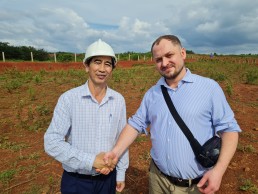
27.01.2023
Bioenergy without land conflicts
The cultivation of cassava on disused mining land for the production of bioethanol makes a meaningful contribution to climate protection in Vietnam.
For years, bioethanol production has been criticized for competing with the food industry for agricultural land. However, our project study from Vietnam shows that growing cassava on abandoned mining land circumvents this conflict, as such land is unsuitable for food production. The use of the resulting bioethanol leads to CO2 savings of up to 50% compared to conventional fuels.
Vietnam’s energy demand is steadily increasing due to economic growth and industrialization. In this context, the share of renewable energy is expected to increase from 3.7% in 2020 to 10% in 2030. To achieve this goal, the Vietnamese government has mandated the blending of bioethanol and the recultivation of abandoned mining areas. UfU benefits from this because in our CPEP project, we work with mining companies that use cassava to recultivate their abandoned mining land in order to make additional profits from the sale.
Abandoned mining sites are often contaminated by heavy metals and other toxins due to past activities, making them unsuitable for food production. Therefore, the cultivation of cassava does not compete with food production and is a suitable reclamation measure. On UfU’s test plots in Vietnam, cassava yields are in the good middle range at 25 tons per hectare. National average yields range from 13 to 35 tons. However, only 2 tons of ethanol per hectare could be produced, 1.5 tons less than the average. This indicates low sugar content due to lower soil quality.
Using bioethanol from cassava grown on abandoned mining land can save up to 50 percent in CO2 emissions compared to conventional fuels. This saving is also significantly higher compared to conventionally produced bioethanol. For example, large areas of rainforest are often cleared for conventional biofuel production, resulting in immense CO2 emissions. However, the negative effects of land-use change are avoided when using abandoned mining sites.
The cultivation of cassava on abandoned mining areas for the production of bioethanol can be a sustainable way for Vietnam to meet the increasing energy demand and at the same time save CO2 emissions. For this reason, the follow-up project will further analyze the cultivation and economic utilization of cassava in order to successfully scale up the production of bioethanol.
More on the opportunities and challenges of bioethanol production in Vietnam can be found in our new UfU paper:


